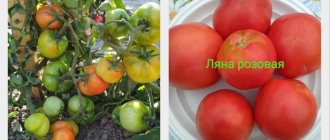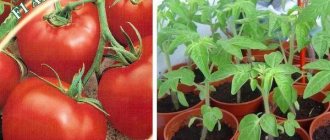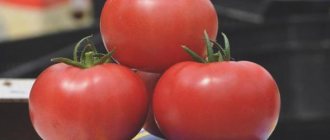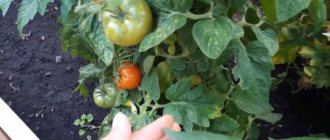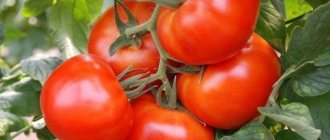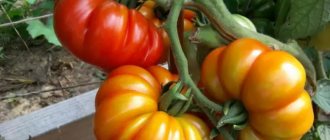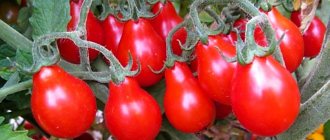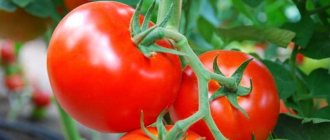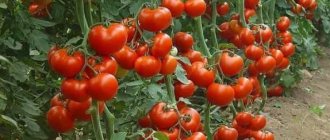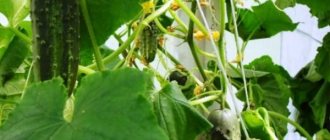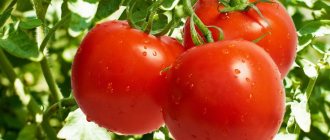Features of determining the best view
Which tomatoes are best to plant in a greenhouse? The best tomato seeds for a greenhouse should be selected based on some important parameters. The culinary purpose, the degree of comfort in the greenhouse, the level of yield, the timing of berry picking, and the strength of resistance to disease must be taken into account.
You can choose varieties and hybrids for the greenhouse. The latter are obtained through the process of crossing varieties. But you cannot collect seeds from them for future planting. Whereas from varietal varieties, the seeds may be suitable for subsequent sowing.
Breeders regularly develop new greenhouse varieties and hybrids of tomatoes. They are distinguished by high productivity, they withstand bad weather and insufficient care much better. The most popular new varieties of tomatoes for greenhouses, judging by many positive reviews from vegetable growers, are Druzhok F1, Tornado F1, Empire, Snow Fairy Tale.
Druzhok F1 tomatoes ripen early. The harvest ripens at the same time, is well stored and transported. It does not grow high, up to 60 cm, but due to the large number of fruits it must be tied to a support. The roundish-red fruits weigh 110 g. Everyone will certainly enjoy the sweet, sugary taste of the fleshy interior.
Experienced vegetable growers annually try to plant new varieties in their garden plots, in addition to their proven favorite tomatoes. For lovers of new things, we can note the following best varieties of tomatoes for 2018 for greenhouses: Kronos F1, Alsou, Banana Legs, Sprinter.
To plant a tomato bush in a greenhouse, you also need to take into account the height of the structure. Some varieties require additional strengthening of the stem, since their growth can be more than 2 meters.
The best varieties of tomatoes for greenhouses have different stem heights.
The short best varieties of tomatoes for greenhouses are distinguished by the fact that the height of the stem is no more than 75 cm. The stem is powerful and thick. They require minimal care. The following species can be classified as undersized: Lionheart, Piglet, Alaska, Pyshka F1, Peach.
Growth-limited varieties stretch up to one meter and stop growing. It is necessary to form a stem for the bush; it is necessary to carry out the pinching procedure. Well-known medium-sized greenhouse tomatoes include: Pink Honey, Sultan F1, Lady, Baby F1.
Tall species are often blessed with large fruits. They cannot boast of high disease resistance, they grow up to two meters and it is recommended to take time to form the stem. It is imperative to construct a support for tying and regularly cut off the side branches.
The best varieties of tomatoes for greenhouses with a bush height of up to 2 meters: Mushroom Basket, Madam, Pink Tsar.
Unique taste
How to choose the right and suitable variety, the taste of the tomato plays an important role. Not everyone likes the sour tint. Therefore, sweet varieties of tomatoes have been created that will attract people with their meatiness and low seed content.
The sweetest varieties of vegetables, according to experienced experts in this matter, are: Eldorado, Pink Honey, Honey Spas, Clubfoot Bear, Cardinal. These varieties not only have an incomparable taste, but are also hardy. They tolerate heat or cold well, lack of microelements in the soil, and also resist viruses and bacteria.
Eldorado can grow up to 90 cm; it is recommended to form two stems from the bush. Each bush has 5 branches, on which yellowish-orange fruits weighing about 400 g are formed. The sweet, juicy pulp is covered on top with a thin but dense skin. The plant needs to be watered, loosened and fertilized in a timely manner.
The Honey Spas variety is characterized by medium boundaries of fruit formation. You can harvest up to 5 kg of crop from one bush. The stem reaches a height of 175 cm, so tying is required. The fruits ripen gradually throughout the summer. Yellow ripe tomatoes are stored for a long time, cracks are not typical.
The Mishka clubfoot variety will be remembered not only for its sweet, pleasant taste, but also for its large number of berries. It exhibits high resistance to many pathogens and has average maturation limits. The color may vary, and the weight sometimes reaches 900 g. Ripe berries have a high sugar content.
You can try sugar cream early, after 83 days. The bush can grow up to 140 cm. The fruits have a yellow tint, the appearance resembles a plum, are rich in carotene, and weigh only 18 g. Tomatoes are stored for a long time, retaining their taste and shape.
Bag F1 pleases with burgundy-red fruits, weighing 245 g and has medium ripening limits. The shape is also unusual, in the form of a cube. The bush grows up to 185 cm, requires staking, cutting off side branches and forming a stem. The dense but delicate skin protects against cracking and promotes good shelf life of tomatoes.
Why tomatoes crack and how to avoid it
Adding an article to a new collection
Growing tomatoes is not an easy task. It takes a lot of effort to enjoy these delicious vegetables in the summer. Problems can occur at any stage of growing tomatoes.
The tomato is a capricious one. He doesn’t like it, it doesn’t suit him. One causes the ovary to fall off, another causes the leaves to curl, and the third causes spots to appear.
But even if all these diseases and misfortunes were avoided, and all your tomatoes as one are healthy, handsome, do not rush to breathe a sigh of relief. Healthy ripening tomatoes also have problems. One of the most common is fruit cracking.
Fighting diseases
The confined space of a greenhouse promotes the rapid spread of diseases. Since the composition of the soil remains constant, fungi and bacteria can be difficult to get rid of. It is imperative to disinfect the room and ventilate it regularly.
Most often, plants get sick due to improper watering, sudden temperature fluctuations, dense plantings in the beds and insufficient care. Therefore, if there is not enough time for care, there is no experience or other reasons, you need to choose seeds that are resistant to disease.
The best varieties for greenhouses, which are distinguished by their persistent, high resistance to many common tomato infections.
Vegetable growers have good impressions of the mid-early variety Virtuoso F1. The plant can reach up to 185 cm. Care includes the formation of the stem. The fruits ripen in 105 days, have a burgundy-reddish hue, a flat-round shape, weighing approximately 145 g. They tolerate adverse weather conditions well and do not allow infection by many viruses.
If you choose Golden Bead F1 seeds, then already on day 94 you can harvest a high harvest. Ripe fruits are spherical, bright orange in color. The brush can contain about 20 sweet, juicy tomatoes weighing 15 g.
A cardinal in a greenhouse can grow up to two meters. The bush requires the formation of a stem, which is strengthened. Raspberry-pink fruits are placed on clusters of 8 pieces and can weigh up to 650 g. The variety tolerates cold and rarely gets sick.
The orange giant will delight you not only with its high resistance to many pathogens. The name can rightfully be attributed to productive varieties of tomatoes for the greenhouse. You will be pleased with the formation of fruits after 103 days. Upon reaching maturity they become orange with a weight of about 450 g.
Early ripening greenhouse tomatoes resistant to diseases and low temperatures
Growing a good harvest of tomatoes in most Russian regions is a lot of work. Gardeners build greenhouses, grow seedlings, and care for plants all summer. Disease prevention and protective measures against diseases and pests take a lot of effort.
The right choice of varieties can make your work easier. Early ripening greenhouse tomatoes have been developed that are resistant to diseases and temperature changes. They produce a high yield, managing to “escape” from diseases and infections.
Delicate shade
Most pink tomatoes for greenhouses differ from red ones in that they contain more nutritional components. They should also be looked after in a special way. Pink tomatoes need soil moisture more and respond more readily to applied fertilizers. Tall stems need to be strengthened and side branches removed.
For planting in a greenhouse, you can select the following best and most popular varieties of pink tomatoes.
Pink honey is the best productive tomato variety for the greenhouse. Large oblong berries have a raspberry-pinkish tint, their weight reaches 1 kg. They begin to ripen after 104 days. The bushes grow up to 1.5 meters, so tying and pinching are required. Sweet tomatoes do not even have a hint of sourness. The thin skin does not do a good job of preventing cracking, so the fruits do not last long.
Pink raisins are memorable for their small red fruits, up to 45 pieces per branch. It stretches up to 1.5 meters. The variety resists diseases well and grows even in bad weather. The oblong berries weigh an average of 75 g and acquire a pink color when ripe. Ripe vegetables can hang on the branches for a long time and not fall off, and the harvested crop can be stored for a long time.
Vegetable growers will like the pink miracle F1 in appearance and taste. Bright raspberry-pink fruits weigh approximately 110 g. Up to 5 pieces can hang on one branch. Vegetable growers note a short shelf life as a disadvantage.
Rich Gifts
Reviews about the best varieties of tomatoes for the greenhouse made it possible to identify the most prolific varieties, which also have other good qualities. High-yielding varieties of tomatoes for greenhouses can be determinate (you need to regularly cut off side shoots) and indeterminate (bushes that grow high and need to be shaped).
What varieties of tomatoes are the most productive for greenhouses will be helped by a rating with a brief description of the type.
Snow leopard is characterized by an average period of fruit formation and after 107 days it will be possible to harvest. The plant is short, about 55 cm, resistant to hot or cold weather. It is necessary to install a support. The fruits are raspberry-reddish in color, with a smooth, round surface, weighing about 250 g. Since they ripen early, they do not have time to catch the spread of most types of diseases.
Rio Grand matures in 116 days from the day of planting. The stems grow to about 1 meter in height. Requires pinching and tying. The fruits are plum-shaped, orange in color, weighing approximately 125 g. The most delicious fruits are from the variety being studied; the pulp is remembered for its juicy, sweet taste. They can grow in dry, hot climates and without regular watering.
Bushes of the Eternal Call variety grow up to 75 cm in height. The yield is extremely high. The branch bears red fruits, weighing about 600 g, which begin to be collected after 85 days. The shape of the berries is flattened with a characteristic ridged surface.
Intuition F1 begins to form fruits already 112 days after sowing the seeds. If you don't pinch the top, it can reach 2.6 meters high. Red in color, round tomatoes have thin but quite durable skin. They are not prone to cracking. The pulp contains a lot of sugar, so they give the dish a special taste and aroma.
The Ivanhoe F1 variety can please you with its high yield. The stem grows large and powerful, and accommodates a large number of clusters of red vegetables of the same size. The vegetable is resistant to most types of viruses and fungi. The reviews note that there is no need to use chemicals when growing.
High-yielding tomato varieties for greenhouses require additional care and a lot of attention. It is imperative to carry out foliar and root feeding according to the scheme. Even if the bushes are small, they need to be strengthened. Every two weeks it is necessary to carry out the pinching procedure. It is recommended to loosen, water and weed the soil in a timely manner.
How to avoid cracking tomatoes
To avoid cracking of tomatoes in a greenhouse and in open ground, you need to remember the rules for growing tomatoes.
Mulching will protect the soil from drying out quickly. Mown grass, straw, and other materials are suitable as mulch.
Take a close look at your cracked tomatoes. Perhaps you just made some mistake in agricultural technology, so they burst? We hope our tips will help you avoid this problem in the future.
Various deadlines for collection
The best varieties of tomatoes for greenhouses with late ripening limits are most often intended for winter dishes; early vegetables can be eaten fresh or added to salads.
The best tomato varieties for greenhouses with early fruit formation, chosen by most vegetable growers.
Buddy F1 begins to mature after 87 days. The bushes are not too branched; they grow about 60 cm in height. They can also be planted in open beds, but the tomato feels better in conditions inside a greenhouse. Red tomatoes with an orange tint weigh about 105 g and are stored for a long time due to their dense structure. The variety is distinguished by its unpretentiousness to soil composition or weather conditions, tolerates temperature fluctuations and rarely gets sick.
In a greenhouse, the tomato variety Ilyich F1 will give a rich harvest, rarely gets sick, and the reddish fruits with an orange tint can be tasted after 87 days. Tomatoes in a greenhouse can grow up to 155 cm in height. The mass of each vegetable is 110 g. The shape is slightly compressed with noticeable ribbing near the stalk. In a greenhouse it is often subject to blossom end rot.
My love F1. The bushes can stretch up to 120 cm. To increase the amount of fruit formation, it is recommended to carry out pinching. The fruits grow large, their weight can reach 210 g, their shape is elongated, with a small spout at the base. The bright red, smooth, thin skin hides a sweet, sugary interior.
Greenhouse tomatoes of the Pervoklaska variety are low-growing, early-ripening varieties. The stem grows no more than 90 cm, but there is a need for tying. To reap the largest possible harvest, it is recommended to form three stems. Ripe bright pink fruits weigh approximately 170 g. The shape is slightly flattened.
Aphrodite will allow you to enjoy your first vegetables in 78 days. The height of their stem reaches only 55 cm, but it is better to tie it to a support, since the thin stem can break under the mass of fruits. Each branch can accommodate 7 round, red-scarlet tomatoes weighing about 95 g.
To harvest in August, it is recommended to plant tomato seeds for greenhouses with late ripening limits. The best late varieties of tomatoes.
The De Barao tomato variety is known among gardeners for its excellent qualities. It belongs to the productive varieties of tomatoes for greenhouses. From one root it will be possible to remove up to 9 kg of vegetables. The land on which the species is supposed to be grown must be fertile. The plant is resistant to many viruses and bacteria.
Tomatoes of the Andreevsky Surprise variety can be recognized by their powerful stem, which requires formation and strengthening. Vegetable growers note that the number of fruits produced on such a tall plant is not very high. The berries, red with a pink tint, weigh about 350 g and have a rounded-flattened shape. The culture tolerates lack of light well.
The miracle of the market belongs to the medium-late group in terms of ripening, reaching a height of up to 130 cm. The fruits are red in color and have a round, slightly elongated shape. The weight of the berries reaches 350 g. These are productive tomatoes. Often subject to rot.
The variety of greenhouse tomatoes Brown Sugar will attract attention with its unusual brownish-brown color. It is characterized by late ripening, tolerates cold air and steadfastly resists disease. In a greenhouse it grows up to 2.5 meters. The fruits are not very large, weighing about 110 g. The taste is excellent, the inside is fleshy, sweet with sufficient juice content.
Large-fruited species
Large-fruited tomatoes can become a real decoration and pride of a greenhouse. Their weight can sometimes exceed 800 g. The harvest is large and of high quality. Large varieties of tomatoes are pleasant to grow and convenient for winter storage without processing for juices, sauces, and salads.
The most popular varieties of tomatoes for greenhouses, which are distinguished by large, tasty berries.
Orange miracle is distinguished by large vegetables weighing more than 155 g. It belongs to the sweet varieties of tomatoes for greenhouses. They start singing early. 5 orange-yellow, oval-elongated berries are formed on the cluster. The skin is thin, dense, but not hard and protects against cracking.
Tomato varieties for the greenhouse are not complete without mentioning the name Pink Elephant. If you follow the rules of watering and fertilizing the soil, each bush will give a large, abundant, sweet harvest. The stem can grow up to 1.5 meters, so it needs to be tied tightly and pinched.
The average weight is 500 g, but can reach 1 kg. The dark pink fruits have a flattened shape with ribbing near the stalk. Delicious tomatoes have a sweet taste without sourness.
Large-fruited varieties are headed by Bull's Heart. Red-scarlet heart-shaped tomatoes are popular among vegetable growers. The weight of one tomato on the lower branches can reach up to 1 kg. On the upper branches the weight of the berries decreases. The fruits ripen in 125 days, therefore they are classified as mid-ripening varieties.
The stem is powerful, spreading with strong tassels that can support up to 5 tomatoes. These greenhouse tomatoes require careful and careful care. It has weak disease resistance and needs to be constantly fed.
Large-fruited varieties cannot do without mentioning the Monomakh Cap species. It is famous not only for its large fruits. This is the most productive variety. It has medium ripening limits. Tomatoes are disease-resistant, delicious in taste, tolerate drought well and ripen almost simultaneously. The red-burgundy fruits are round in shape and weigh approximately 450 g, but can reach 900 g.
Tomatoes for greenhouses King of the Market are early-ripening hybrids and have a lot of positive properties. Red-scarlet tomatoes are resistant to diseases, temperature changes, and can tolerate lack of moisture. Vegetable growers note that it is possible to grow the variety only in the southern regions.
Let's defeat late blight: choosing the “right” varieties of tomatoes
No matter how dangerous late blight is, a true gardener-enthusiast will never refuse registration of fragrant tomatoes in the garden. The difference in taste between purchased tomatoes and home-grown tomatoes is too great!
Meanwhile, it seems that the more persistently we want to get rid of late blight, the more aggressive it becomes. Even a balcony or greenhouse does not always help protect plants from this scourge, because late blight is constantly mutating. It has reached the point where even resistant new breeding products are unable to resist the fungal disease. However, not everything is so sad: in new varieties, only the old leaves suffer, but the fruits remain healthy and tasty, and the bush itself stubbornly grows further.
Which tomato varieties are resistant to late blight?
that have the closest connections to their wild relatives , such as 'Golden Currant' and ' Rote Murmel ' , have the highest immunity to the disease . They are, one might say, ideal candidates for open ground, the only problem is that their fruits are small. But the most beloved salad varieties with large fruits, for example ' Bull's Heart' , as luck would have it, are the least resistant to late blight. Such tomatoes especially need a “roof over their heads,” that is, they need a canopy that will protect the plants from rain, because it is in wet weather that the disease gains momentum. Specially bred varieties such as 'Primabella', 'Primavera' or 'Resi' , which are intended for cultivation in open ground, have completely different qualities. They have been tested for late blight resistance in different regions and under different conditions over the years. The result showed that even with moderate fertilization and watering, plants of these varieties give a good harvest and remain healthy. Tomatoes ripening in the sun have a unique taste and aroma. Varietal plants intended for cultivation in open ground produce crops from mid-July until September, even if summer periodically takes days off.
Tomatoes come in completely different colors, shapes and sizes. And if you choose the right variety , growing tomatoes will be a real pleasure.
- The fruits of yellow pear-shaped tomatoes ' Yellow Submarine' weigh only 15 g. But their taste will not leave any connoisseur of this heat-loving vegetable indifferent.
- 'Tommacio' tomato has small fruits, but there are a lot of them. Tomatoes can be collected individually or in whole clusters.
- Bush tomatoes such as 'Pendulina Orange' and 'Ida Gold' are ideal for growing in boxes and hanging planters.
- Black tomato fruits, such as ' Indigo Rose', 'Black Russian' or 'Black Cherry' , have thick skins and a sour, fruity taste.
- ' Banana Legs ' is one of the most productive old varieties of tomatoes.
- ' Yellow Pearshaped ' is an early variety with numerous sweet pear-shaped fruits.
- 'Bull's Heart' is a late-ripening tomato. The peel of the fruit is thin, the aromatic pulp of fully ripe fruits becomes not very juicy.
- ' Sacher' with its mouth-watering fruits with a glossy dark brown skin is also called the chocolate tomato.
If you are not sure that the tomatoes you planted this year are resistant to late blight, do not worry: the recommendations from the articles How to prevent late blight of tomatoes and Traditional methods of combating late blight of tomatoes will help you prevent and defeat it. And you can be more careful in choosing seeds in advance, because they remain viable for about 4 years . But they need to be stored in a cool, dry place.
You can plant tomatoes directly in a bag of substrate. Choose low-growing varieties for this.
Ideal partners for tomatoes in the same bed are herbs and medicinal plants. Borage, for example, produces saponin, a substance that stimulates root growth. Comfrey and nettle can be used for mulching: as they decompose, their leaves and stems strengthen the immunity of tomato bushes due to their iron content. You should be careful with watering and feeding tomatoes : if you overdo it, they will produce more leaves than flowers, and the harvest, as well as the taste of the tomatoes, will disappoint. But the sense of proportion here depends on the type of soil. So, clayey soil contains more water and nutrients than sandy soil. Alternatively, select 1-2 plants and feed them only a little or not at all, while providing the others with good nutrition. This way you will understand exactly under what conditions the tomatoes will be especially aromatic and will surprise you with the quantity and quality of the harvest. And as in any experiment, the result needs to be tested. And with such a tasty “guinea pig”, you must agree, it’s a real pleasure!
Irina, Bendery
“My Beautiful Garden” presented a detailed article about different varieties of tomatoes, their planting and care, with particular emphasis on the disease “Late blight”. Last year I planted about 500 tomato bushes of various varieties. These were both loved by me and my family, and we specially chose new varieties resistant to Late Blight. Moreover, I took both our varieties and Dutch ones (we generally sold these by the seed). The result is that late blight did not figure out which varieties were resistant in my garden and which were not, and completely destroyed almost the entire crop. Although I sprayed with copper sulfate, I used Fitosporin, and watered only under the bushes. This year I planted almost the entire garden with potatoes. I left a couple of beds for tomatoes, just to eat.
Tata, Kaluga
Irina, it’s not for me to teach you, because where you live, everyone is an expert in the tomato business, and the climate is conducive. I just want to note that you need to separate the plantings of tomatoes and potatoes, and not plant them close and after each other. This may help inexperienced gardeners... Potatoes and tomatoes have a common enemy - late blight.
Tata, Kaluga
I spent a lot of money on seeds and 4 months of work, plus 40 thousand on a greenhouse, not to mention trips to the country. Result: huge tomatoes were devoured by late blight in one night. Fitosporin and metronidazole did not give any results. There is no mood this year. Again the same result will happen.
Tata, Kaluga
Maybe you have already read my words about my experience, but I will repeat... In fact, it is very offensive in such cases, and this happened to me. Until I developed my own method of combating late blight. Of course, tomatoes need constant attention to get results. I grow tomatoes in a polycarbonate greenhouse, 200 km from Moscow, i.e. the climate is not tomato-like... Moreover, the area is between two rivers, one of which is cold and key! It’s foggy almost every night, so we close the greenhouse every evening and open it in the morning. You need to be “friends” with late blight, and for this you need to work hard... And you need to start a week after planting in the ground or greenhouse. Every week I spray tomatoes with different compounds, I have developed a pipeline of treatments for myself in order: brilliant green, iodine, garlic tincture, phytosporin solution, ash extract, potassium permanganate in combination with boric acid, garlic again... As you can see, almost all of these are folk remedies, no chemicals . And I don’t have late blight; I vacate the greenhouse in October, when the frosts catch the plants in the greenhouse. It is very important that the greenhouse is dry, especially during the fruiting period. Source: https://www.7dach.ru/AnastasiaCh/kto-vyraschival-zheltye-tomaty-i-belye-baklazhany-kakie-sorta-horoshie-podelites-mneniem-50994.html#ixzz3yKuXlJul
Tata, Kaluga
I grow different tomatoes. Lettuce, tall, I form into 2 stems - Black Prince, Persimmon, Ox's Heart... And medium-sized, for preservation - canned pear, pink Leader, balcony miracle, Moskvich... And there is more, without a name... And if they get sick, then no one can protect themselves , that’s why I check it every morning... If I notice a speck, I’ll immediately go into action, here all means are good, don’t yawn!
This is a Bull's Heart and a couple of small Black Princes. Thank you very much for the advice! I have exactly the same conditions: 100 km. from Moscow and a hundred meters from the river, and also foggy. I'll try to apply your tips!
7dach.ru
